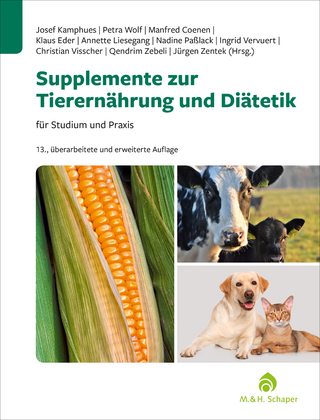
INRA feeding system for ruminants
Seiten
2018
|
2nd New edition
Wageningen Academic Publishers (Verlag)
978-90-8686-292-4 (ISBN)
Wageningen Academic Publishers (Verlag)
978-90-8686-292-4 (ISBN)
- Titel ist leider vergriffen;
keine Neuauflage - Artikel merken
The INRA Feeding System for Ruminants has been renewed to better address emerging challenges for animal nutrition: prevision of productive responses, product quality, animal health and emissions to the environment, in a larger extent of breeding contexts. The new system is mainly built from meta-analyses of large data bases, and modelling. The dietary supply model accounts for digestive interactions and flows of individual nutrients, so that feed values depend on the final ration. Animal requirements account for variability in metabolic efficiency. Various productive and non-productive animal responses to diets are quantified.
This book presents the whole system for dairy and meat, large and small ruminant production, including specificities for tropical and Mediterranean areas. The first two sections present biological concepts and equations (with their field of application and statistical accuracy) used to predict intake (including at grazing) and nutrient supply (Section 1), animal’s requirements and multiple responses to diets (Section 2). They apply to net energy, metabolisable protein and amino acids, water, minerals and vitamins. Section 3 presents the use of concepts and equations in rationing with two purposes: (1) diet calculation for a given performance objective; and (2) prediction of the multiple responses of animal to diet changes. Section 4 displays the tables of feed values, and their prevision. All the equations and concepts are embedded in the fifth version of INRAtion® software for practical use.
This book presents the whole system for dairy and meat, large and small ruminant production, including specificities for tropical and Mediterranean areas. The first two sections present biological concepts and equations (with their field of application and statistical accuracy) used to predict intake (including at grazing) and nutrient supply (Section 1), animal’s requirements and multiple responses to diets (Section 2). They apply to net energy, metabolisable protein and amino acids, water, minerals and vitamins. Section 3 presents the use of concepts and equations in rationing with two purposes: (1) diet calculation for a given performance objective; and (2) prediction of the multiple responses of animal to diet changes. Section 4 displays the tables of feed values, and their prevision. All the equations and concepts are embedded in the fifth version of INRAtion® software for practical use.
| Erscheinungsdatum | 29.01.2018 |
|---|---|
| Sprache | englisch |
| Maße | 170 x 240 mm |
| Gewicht | 1 g |
| Themenwelt | Technik |
| Veterinärmedizin ► Allgemein ► Tierernährung / Tierhaltung / Tierzucht | |
| ISBN-10 | 90-8686-292-6 / 9086862926 |
| ISBN-13 | 978-90-8686-292-4 / 9789086862924 |
| Zustand | Neuware |
| Informationen gemäß Produktsicherheitsverordnung (GPSR) | |
| Haben Sie eine Frage zum Produkt? |
Mehr entdecken
aus dem Bereich
aus dem Bereich
Grundlagen - Fütterung - Diätetik Begründet von Helmut Meyer
Buch (2022)
Thieme (Verlag)
CHF 106,90
Praxisleitfaden für eine tiergerechte Hühnerhaltung
Buch | Softcover (2023)
Landwirtschaftsverlag Münster
CHF 62,70


